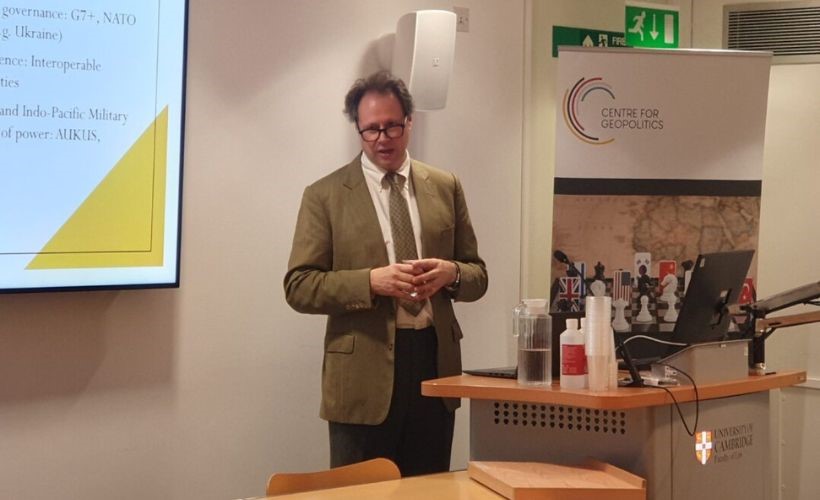Dr Kun-Chin Lin, former Deputy Director, Centre for Geopolitics
The head of the Chinese Lunar Exploration Program, Ye Peijian, remarked in 2019 that: “… the universe is an ocean, the moon is the Diaoyu Islands, Mars is Huangyan Island. If we don’t go there now even though we’re capable of doing so, then we will be blamed by our descendants. If others go there, then they will take over, and you won’t be able to go even if you want to. This is reason enough.” Diaoyu is known as the Senkaku Islands to the Japanese, and Huangyan is the Scarborough Shoal – both are sites of recent naval and legal contestation, with the latter serving as a strategic beachhead for Chinese maritime expansionism in the SCS and beyond.
The analogy above points to strong connections between Chinese leaders’ and scientists’ conceptualisations of physical space and interstate power relations in the maritime and space domains. In the 1950s and 1980s, China faced extreme vulnerability to American and allied naval forces along its long coastline. As the Sino-Russian rift rapidly widened, Mao’s threat perception was triggered to a significant extent by Russian naval ambitions. He reacted vehemently when Nikita Khrushschev proposed in 1958 a “joint fleet” that would have allowed Russians to control China’s nascent naval development and Russian vessels and submarines to access Chinese ports along its long coastline. As a direct result of these historically conditioned securitisation episodes, Mao directed the costly relocation of industrial capacities away from the coast to the inland “Third Front” and ordered the development of China’s indigenous nuclear submarines. Henry Kissinger knowingly played on this threat perception during the rapprochement negotiations, when he fed intelligence to Mao and Zhou Enlai magnifying the Soviet intention to dominate Asian seas.
Three decades later, CCP leaders Hu Jintao and Xi Jinping have embarked on a nationalist project of military modernisation, justified with a re-historicised strategic identity of China’s revival as the once and future hegemon. Since 2013, Xi has invested China’s space development with equivalent prestige and resources to Mao’s nuclear programme, declaring that “The space dream is part of the dream to make China stronger.” Accordingly, Chinese strategists have also brought back the notion of “active defense” to justify “defensive”, “self-defensive,” and “post-emptive” strikes with all the weapons of the 21st century on other countries deemed to be acting in strategic encroachment of Chinese interests and territories, which is reminiscent of the just war doctrines of imperial China.
The advantages for China to invest in space are obvious, amplified by what Beijing perceives as an increasingly hostile international political and security climate that has been created by geopolitical rivals around China’s rise. China witnessed how the US military used satellite-based navigation to guide smart bombs to wipe out the world’s fifth-largest army in the first Gulf War, and the subsequent decades of revolution in military affairs by which cyber and space assets – forming the backbone of what is commonly called network-centric warfare – have become essential integrators and force multipliers for the traditional domains of warfare for the US military. China and Russia have countered this development with weapons aimed to undermine conventional deterrence, establish anti-access area-denial capabilities, and launch cyber disruptions. A key focus of their efforts has been to challenge the American superiority with the eyes in the sky – the PLA’s 2007 demonstration of its anti-satellite capabilities using fairly basic land-based missiles sent shockwaves around the US military community. This act heralded the re-opening of space as a contested domain of great powers since the end of the Cold War, compounded by a flurry of activities by numerous states and private actors to put assets into low earth orbital and cislunar space.
Over the past year, China has registered major milestones including landings on the dark side of the moon and Mars, completing the Beidou satellite network, and putting in orbit the first modules of a Chinese space station. Parallel advances in China’s scientific exploration of deep sea, seabed, and polar regions reinforce the knowledge for operating in and ability to benefit from the space domain. In its national planning statements, China has made no secret of its intent to make space ventures serve as a “dragonhead” for the vast array of technologies that China aims to indigenise and take a global lead via its campaign-style industrial policy – Made in China 2025 – and to boost the PLA’s presence in these industries.
In the process of Chinese spatial expansion, functional and political challenges of adapting to climate change, exploitation of natural resources, the blurring of the lines between scientific research and military uses, global supply chain management, and crafting of multilateral governance have become common to both the maritime and space domains. Just as international water was legally conceptualised by Hugo Grotius in the 17th century and the marriage of seapower and mercantilism codified by Alfred Mahan in the 19th century, today’s space, cyber and polar regions are fraught with multilateral, multi-stakeholder debates over sovereignty, sovereign and user rights, mechanisms to prevent a tragedy of the commons, limits of militarisation, uneven development, and the possibility of an open and inclusive governance.
China has entered the fray in a big way without offering principled, committed positions on these critical issues, showing only power-maximising military and industrial policy goals underpinning its basis for strategic adaptation. For other countries that lack offensive capabilities in space, but are increasingly interested in acquiring a stake in the 21st century space game, the prospect of the US exercising self-restrained control of the contested space domain in a manner conceived by the “hegemonic stability theory” maybe the second-best scenario to the ideal future of space as a sanctuary for common humanity and sustainable development. As it stands, the sky is no longer the limit for our understanding of geopolitics.
Deputy Director, Kun-Chin Lin, leaves the Centre at the end of September 2021 to take up a new post as a Professor of Military and Security Studies at the Department of Spacepower, Air University of the US Air Force. He will lead research on US-PRC strategic competition in space, and train officers of US Space Guardians and other countries’ space commands. We thank him for his years of service to the Centre and his excellent scholarship.







